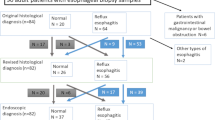Abstract
Background
The aim of this study was to characterize pathological lesions of the esophageal epithelial tight junction (TJ) complex in a rat reflux esophagitis (RE) model in a search for a reliable diagnostic indicator.
Methods
Rats underwent an operation to induce RE, with or without rabeprazole treatment (1.0 and 10.0 mg/kg/day). Sham-operated rats served as a control. Fourteen days after the operation, esophagi were isolated from the rats and submitted to double-label confocal immunofluorescence microscopy, and biochemical analyses.
Results
Immunofluorescence microscopy revealed that claudins-1, -3, and -4 were located on the surfaces of epithelial cells in the normal esophagus of the control group, although there were differences in the distribution patterns between claudin-3 and claudins-1 and -4 in the epithelial layer. However, in RE, the immunoreactivity of claudin-3 on the cell surface was decreased, and it appeared instead as a faint granular pattern within the epithelial cytoplasm. Claudin-3 expression in the entire esophageal epithelium was also decreased. The expression and location of claudins-1 and -4 in epithelial cells were basically unaffected in RE. Gastric acid-induced dissociation of claudin-3 elicited instability of the epithelial TJ complex, which was confirmed by sedimentation analysis using centrifugation in a sucrose density gradient. Rabeprazole (10.0 mg/kg/day) attenuated these alterations.
Conclusions
Our data indicate that the dispersion of claudin-3 from esophageal epithelial plasma membranes to cytoplasm and the resulting instability of the TJ complex could be one of the most specific and sensitive indicators for monitoring inflammatory and recovery processes in RE.





Similar content being viewed by others
References
Fujimoto K. Review article: prevalence and epidemiology of gastro-oesophageal reflux disease in Japan. Aliment Pharmacol Ther. 2004;20(Suppl 8):5–8.
Fujiwara Y, Arakawa T. Epidemiology and clinical characteristics of GERD in the Japanese population. J Gastroenterol. 2009;44:518–34.
Watanabe S, Hojo M, Nagahara A. Metabolic syndrome and gastrointestinal diseases. J Gastroenterol. 2007;42:267–74.
Yoshimura M, Nagahara A, Ohtaka K, Shimada Y, Asaoka D, Kurosawa A, et al. Presence of vertebral fractures is highly associated with hiatal hernia and reflux esophagitis in Japanese elderly people. Intern Med. 2008;47:1451–5.
Corley DA, Kubo A, Levin TR, Block G, Habel L, Rumore G, et al. Helicobacter pylori and gastroesophageal reflux disease: a case–control study. Helicobacter. 2008;13:352–60.
Hongo M, Kinoshita Y, Miwa H, Ashida K. The demographic characteristics and health-related quality of life in a large cohort of reflux esophagitis patients in Japan with reference to the effect of lansoprazole: the REQUEST study. J Gastroenterol. 2008;43:920–7.
Henke CJ, Levin TR, Henning JM, Potter LP. Work loss costs due to peptic ulcer disease and gastroesophageal reflux disease in a health maintenance organization. Am J Gastroenterol. 2000;95:788–92.
Richter JE, Castell DO. Gastroesophageal reflux. Pathogenesis, diagnosis, and therapy. Ann Intern Med. 1982;97:93–103.
Orlando RC. Review article: oesophageal mucosal resistance. Aliment Pharmacol Ther. 1998;12:191–7.
Steed E, Balda MS, Matter K. Dynamics and functions of tight junctions. Trends Cell Biol. 2010;20:142–9.
Tsukita S, Furuse M, Itoh M. Multifunctional strands in tight junctions. Nat Rev Mol Cell Biol. 2001;2:285–93.
Findley M, Koval M. Regulation and roles for claudin-family tight junction proteins. IUBMB Life. 2009;61:431–7.
Staehelin LA. Further observations on the fine structure of freeze-cleaved tight junctions. J Cell Sci. 1973;13:763–86.
Shin K, Fogg VC, Margolis B. Tight junctions and cell polarity. Annu Rev Cell Dev Biol. 2006;22:207–35.
Sonoda N, Furuse M, Sasaki H, Yonemura S, Katahira J, Horiguchi Y, et al. Clostridium perfringens enterotoxin fragment removes specific claudins from tight junction strands: evidence for direct involvement of claudins in tight junction barrier. J Cell Biol. 1999;147:195–204.
Zeissig S, Bürgel N, Günzel D, Richter J, Mankertz J, Wahnschaffe U, et al. Changes in expression and distribution of claudin 2, 5 and 8 lead to discontinuous tight junctions and barrier dysfunction in active Crohn’s disease. Gut. 2007;56:61–72.
Bürgel N, Bojarski C, Mankertz J, Zeitz M, Fromm M, Schulzke JD. Mechanisms of diarrhea in collagenous colitis. Gastroenterology. 2002;123:433–43.
Asaoka D, Miwa H, Hirai S, Ohkawa A, Kurosawa A, Kawabe M, et al. Altered localization and expression of tight-junction proteins in a rat model with chronic acid reflux esophagitis. J Gastroenterol. 2005;40:781–90.
Omura N, Kashiwagi H, Chen G, Suzuki Y, Yano F, Aoki T. Establishment of surgically induced chronic acid reflux esophagitis in rats. Scand J Gastroenterol. 1999;34:948–53.
Asaoka D, Nagahara A, Oguro M, Mori H, Nakae K, Izumi Y, et al. Establishment of a reflux esophago-laryngitis model in rats. Dig Dis Sci. 2010 [Epub ahead of print].
Tanaka M, Katoh Y, Nakajima Y, Kawashima H. Combination effects of rabeprazole and teprenone on gastric mucosal lesion model induced by indomethacin. Jpn Pharmacol Ther. 1998;26:981–7 (article in Japanese with English abstract).
Koike M, Shibata M, Ohsawa Y, Kametaka S, Waguri S, Kominami E, et al. The expression of tripeptidyl peptidase I in various tissues of rats and mice. Arch Histol Cytol. 2002;65:219–32.
Furuse M, Fujita K, Hiiragi T, Fujimoto K, Tsukita S. Claudin-1 and -2: novel integral membrane proteins localizing at tight junctions with no sequence similarity to occludin. J Cell Biol. 1998;141:1539–50.
Nusrat A, Parkos C, Verkade P, Foley CS, Liang TW, Innis-Whitehouse W, et al. Tight junctions are membrane microdomains. J Cell Sci. 2000;113(Pt 10):1771–81.
Fujita H, Chiba H, Yokozaki H, Sakai N, Sugimoto K, Wada T, et al. Differential expression and subcellular localization of claudin-7, -8, -12, -13, and -15 along the mouse intestine. J Histochem Cytochem. 2006;54:933–44.
Hashimoto K, Oshima T, Tomita T, Kim Y, Matsumoto T, Joh T, et al. Oxidative stress induces gastric epithelial permeability through claudin-3. Biochem Biophys Res Commun. 2008;376:154–7.
Miwa H, Oshima T, Sakurai J, Tomita T, Matsumoto T, Iizuka S, et al. Experimental oesophagitis in the rat is associated with decreased voluntary movement. Neurogastroenterol Motil. 2009;21:296–303.
Author information
Authors and Affiliations
Corresponding author
Rights and permissions
About this article
Cite this article
Oguro, M., Koike, M., Ueno, T. et al. Dissociation and dispersion of claudin-3 from the tight junction could be one of the most sensitive indicators of reflux esophagitis in a rat model of the disease. J Gastroenterol 46, 629–638 (2011). https://doi.org/10.1007/s00535-011-0390-1
Received:
Accepted:
Published:
Issue Date:
DOI: https://doi.org/10.1007/s00535-011-0390-1




